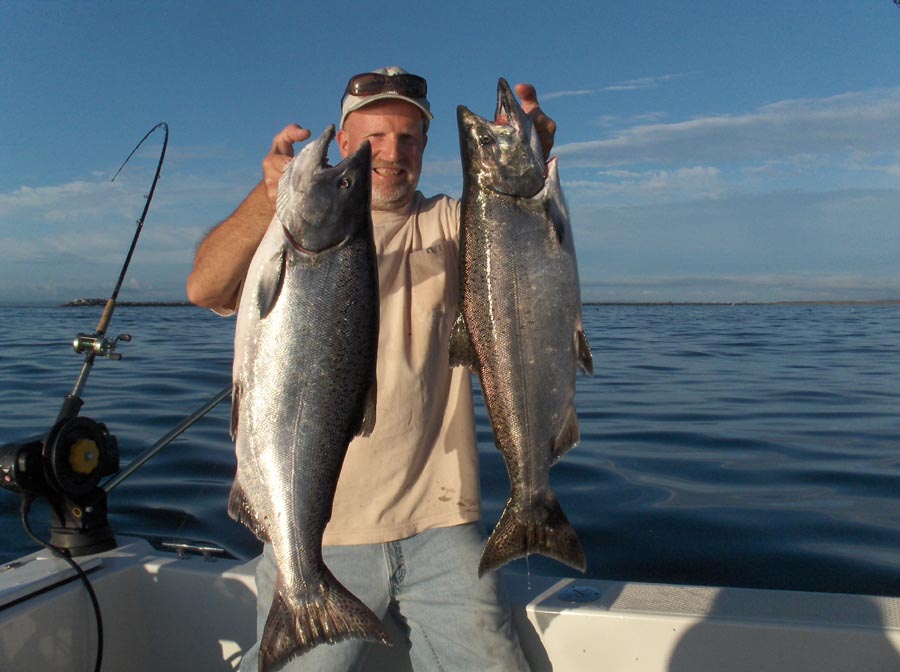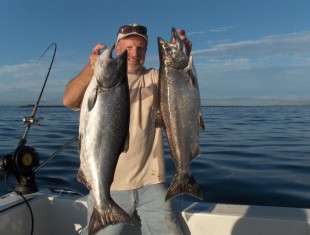
By Earl Sande
One of my early childhood memories when I was about four was playing in the bathtub with my little plastic boat that had a tiny Mercury outboard on the stern. As strange as this sounds, I was convinced Johnson and Evinrude outboards were vastly inferior to Mercury engines.
My dad, uncle and grandfather owned and operated Sande Boat Works. They sold and serviced Mercury outboards, so in my little mind I just figured they had to be the best.
Like many successful companies, Mercury has an interesting history. As a teenager in the 1960s I remember hearing stories about the company founder Carl Kiekhaefer.
One story was about the huge parties he organized at his annual national dealer meetings. For dinner he would barbeque huge thick steaks and serve all the free whisky his dealers could drink. Then they would build a monster bon fire near a crane with half a dozen Johnson and Evinrude engines hanging high in the sky. Just when nearly everyone was blasted, he would give the word to lower the enemy outboards into the fire and the crowd would yell and cheer into the night.
That was some serious industrial propaganda.
Kiekhaefer’s great grandparents left Germany in 1850 and settled on some land bought for $1.25 an acre 15 miles north of a then small village known as Milwaukee, Wisconsin. Elmer Carl Kiekhaefer was born June 4th 1906 on this farm. Six sisters would follow. Carl lived until 1983.
By the time Elmer was seven he was working the farm with the adults. Elmer was born with a gift for understanding practical machinery. In 1917 the family bought a modern engine-powered farm tractor with all the high tech inventions like hydraulics, pneumatics, internal combustion engine with valves and a crankshaft, plus other cool stuff like power takeoffs, brakes, transmissions, ignitions and electrical systems. It wasn’t long before the young lad was taking these things apart and putting them back together to make repairs or just to see how they worked.
After graduating from high school, Elmer had enough of the hard farm life and in 1924 started attending the Milwaukee School of Engineering. The next year he had a huge argument with his father about leaving the farm. That would change his life forever.
His father yelled, “If you’re leaving, really leaving, then leave for good. Don’t ever come back!”
Carl was upset, but now was more determined than ever to make it as a mechanical engineer. One of his first jobs was at Nash Motors as a layout draftsman. Next he started working at Evinrude Motors, but was fired after three months for arguing with one of the head engineers about outboard design.
Carl’s next job, in 1928, was at Stearns Magnetic Manufacturing Company. He was soon designing new products for the farming and livestock industry. He also went to night school to study electrical engineering. By 1933 he was superintendent of the plant. But Carl wanted to run his own company and soon enough he got his wish.
The Cedarburg Manufacturing Company that made Thor Outboards was broke. Some business people in Cedarburg, Wisconsin knew they could buy the land, building and business for a fraction of what it was worth. They also knew Carl and asked if he wanted to join this business venture, run the company and try to make improvements to the outboards at the factory. On January 22, 1939 Carl walked through the door of the Cedarburg Company and took possession.
“There were 12-foot snow drifts outside,” Carl said years later. “It was 22 degrees below zero inside. When I walked through the plant I saw no coal for the boiler, a bunch of broken-down lathes and other old-fashioned broken-down machinery. It was probably the most depressed I had ever been in my life. I had no product, I had no employees and no money, but I did have resourcefulness.”
The new company was called Kiekhaefer Corporation. Carl had about 90 days to make some money or go belly up. He first hired some men that had worked there, and then he re-designed the carburetor so the single Rosi cylinder outboard would run.
Next, Carl re-designed the ignition system. After that he removed the crude crankshaft and replaced it with a nicely forged one from a two-horse Elgin Waterwitch outboard. Now he had a motor that would run.
Within a few weeks he had modified six engines and sent them to Chicago for inspection. Montgomery Ward was impressed and reinstated a canceled order for 500 outboards. In the first 90 days he sold 884 outboards. The new company was off and running.
By this time, Carl had a wife and two kids, although they hardly ever saw him because he usually worked from six in the morning until midnight, seven days a week.
In 1940 Carl re-designed the new motors and called them Mercury Outboards. Montgomery Ward and Western Auto Supply ordered 32,000 of them under the name Sea King and Wizard. Carl worked like a man possessed. Improvements in machinery, employees and outboards were constantly being made.
While Carl was at the New York Boat Show in 1940 some of the investors in the company decided they could make a quick $12,500 if they sold their shares to the Flambeau Outboard Motor Company. Carl raced back to Cedarburg to talk them out of it. Carl would trust few people for the rest of his life. He made all the stockholders sign documents so that any stocks had to be sold to the company. This was the first of many stock manipulations that eventually placed 90 percent of the company stock in Carl’s hands.
At the 1941 New York Motor Boat Show, Carl made sure everyone knew that a new super deluxe Mercury motor was on the way. The Thunderbolt was an inline four-cylinder Mercury outboard that would shock the world.
But the only shock for America that year was the Japanese bombing Pearl Harbor. This would turn the Kiekhaefer Corporation upside down! With one swipe of the pen the government stopped all sales of aluminum unless the company had a contract to build something for the war effort.
Mercury was only about a year old and without a long track record only Evinrude, Johnson and Elto were in the running for outboard wartime contracts.
So Carl went to work to design a tough, reliable five-horse engine for the war that could be used for chain saws, generators or other things. He designed other smaller engines that could be used for compressors, grinders and other similar items.
In 1943, after a year with almost no income, a $2.5 million contract came in for 10,000 engines that saved the company.
After the war, outboard sales started pouring in and production of newly designed outboards rolled down the assembly lines. In 1946 Carl bought a huge barn on 500 acres near Fond Du- Lac, Wisconsin. This was soon remodeled into a modern manufacturing facility.
That year the new 10-horse Mercury motor he built caused some real excitement. It was very fast because it was really a 16-horse.
Then the long-awaited inline four-cylinder, 25 horse came out and it was fast too, because it really had 40 horse-power. Carl loved to be conservative with his horse-power ratings. That way he could say he built the fastest motor of that horse-power.
Carl got the racecar bug in 1951. He spent about a million dollars in the next two years racing cars and was seriously involved in car racing until 1957. That money should have been spent developing new outboards, but before it was too late he got the outboard bug back and the company was off and running full bore again.
In 1957 the Mercury Mark 75 was the world’s first six-cylinder outboard. At 60 horse power it was 20hp ahead of the competition. (Carl sometimes had some wild ideas and one was building a large outboard without a neutral gear. It had to be started in forward or reverse and got a nickname … the dock buster!) This motor actually ran backwards for reverse, creating engineering problems because the starter and water pump had to work in either direction. The experiment lasted about two years and that was enough of that.
In the late 1950s, one of Carl’s engineers came up with a stern-drive design. A car motor on the inside and an outdrive on the outside. Carl thought it was a crazy idea. So the engineer went to Sweden and they loved it. In 1959 Volvo came out with the first dependable sterndrive system and like usual Carl went berserk. But in 1961 he came out with his own style inboard-outboard system called the mercruiser.
The company finally got too big for Carl to handle. He trusted very few people and tried to do too much himself. Carl sold his Kiekhaefer Corporation to the Brunswick Corporation in 1964 for $34 million in Brunswick stock at 63 dollars a share. In less than one year the stock was worth less than six dollars a share, which was a loss of $30 million in one year.
Carl was devastated. He had almost given his company away. After a three month binge and thoughts of self-destruction, he emptied sixteen bottles of booze down the drain and was ready to face the world again, and he stayed on as president at Mercury. Besides, Evinrude and Johnson had not been conquered yet.
Carl still didn’t like the like the stern drive idea. But when they signed a deal with General Motors for engines and made more improvements on the drive system, the Mercrusier eventually captured more than 80 percent of the world market leaving OMC (which made Evinrude, Johnson and OMC sterndrives) in the dust. OMC went bankrupt in the year 2000.
Carl was a tough guy to work for. He fired then hired his engineers back the next day many times. He once fired a delivery man for standing around, giving him two weeks pay on the spot, mistakenly thinking he worked for Mercury.
Today, Brunswick’s Mercury Marine is still a major player in the world’s marine market place.
For much more information about the marine industry before the turn of the century read IRON FIST by Jeffery L. Rodengen published in 1990.

